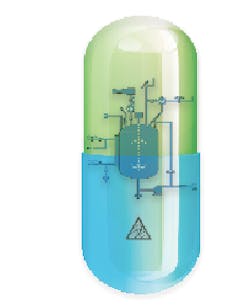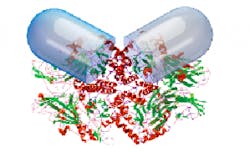Until recently, pharmaceutical active product ingredient (API) developers were limited to selecting from a roster of chemical catalysts to perform the transformations needed for drug manufacturing. However, given that there are a multitude of bases for developers’ API route decisions — including patient safety, transformation efficiency, development speed, cost, process robustness, product quality, environmental impact, process portability and manufacturing worker safety — the more options we have to achieve these goals, the better.
Additionally, API development organizations must create increasingly complex molecules for an expanding roster of novel therapeutics within shortening development timelines. New pressures and requirements call for new options. Thankfully, the industry does have a more modern catalytic option with an expanding application base: enzyme-based biocatalysts. So how did we get here?
By the late 1880s, scientists were able to systematically vary the structure of chemical substances, along with their emerging pharmacological knowledge, which enabled them to create the building blocks for today’s pharmaceutical industry. Over the decades, chemists have become quite good at using various chemical catalysts, typically metal-based, to create drug products. Although these catalysts are adequate, they do have their drawbacks, such as a higher risk of product impurities, generation of hazardous waste, less efficient processes, and new regulatory pressures.
Biocatalysis: Using biocatalysis instead of traditional chemistry can dramatically simplify the operational aspects of the transformation process and can enable much higher space-time yields.
Attempts were made in the 1990s to begin using enzyme catalysts, given their cleaner and less toxic approach to pharmaceutical API manufacturing; however, these early days relied upon wild-type enzymes limiting substrate scope to “natural looking” substrates only.
Thankfully, Dr. Willem P. C. Stemmer and Frances H. Arnold, the Linus Pauling professor of Chemical Engineering, Bioengineering and Biochemistry at Caltech, and her team, worked hard to develop a remedy for this situation. The Royal Swedish Academy of Sciences awarded Arnold the 2018 Nobel Prize for Chemistry for “the directed evolution of enzymes,” an exciting honor for her and Caltech as well as for the expanding community of scientists working to advance engineered enzymes for commercial applications. The directed evolution technology first developed in her lab was licensed and ultimately became a foundational asset for the protein engineering company, Codexis, when it was formed in 2002.
Two extremely viable transformation options are now available for pharmaceutical API manufacturing — chemocatalysts and biocatalysts. How do developers weigh and decide which transformation option is the best? What developments are on the horizon? What can we do now that we were unable to do before? And what are the challenges before the industry? For this article, these questions were explored with highly experienced experts in the field: Jake Janey, head of automation, catalysis, and biocatalysis in chemical and synthetic development, Bristol-Myers Squibb; Yaohui Ji, vice president of research and development, Porton Pharma Solutions; Rob Miotke, owner, Advantage Pharma Solutions; Jim Bruno, president, Chemical and Pharmaceutical Solutions; and Rob Wilson, senior vice president of business operations, Codexis.
Why should an API developer consider using biocatalysis rather than chemocatalysis?
Rob Wilson: The choice to use a biocatalytic route is fundamentally about shortening development timelines, improving yields, and making the process easier and more future-proof. Chemocatalysis, or traditional chemistry, is a well-developed field and there are many tools, technologies, and approaches available. However, conventional chemical processes often produce hazardous waste under potentially dangerous operating conditions, require specialized equipment, or are merely inefficient. Using biocatalysis, manufacturers can layer multiple catalytic steps or even use a one-pot cascade approach. This dramatically simplifies the operational aspects of the transformation process and can enable much higher space-time yields.
The highly selective nature of biocatalytic reactions is the essential value proposition. The more complex a drug is — and drug molecules are becoming increasingly complex — the more likely it is to have three, four or five of the same functional groups on different parts of the molecule. By selectively functionalizing only one group without a need to multiply protect, and deprotect the others because they could be reactive within a traditional chemical setting, manufacturers can eliminate steps.
Because of enzymes’ high level of selectivity, manufacturers can streamline synthesis to a minimal number of API and/or intermediate forming steps within a transformation sequence. When a process developer is smart about approaching a process, big chunks of a synthetic route can disappear.
Being so selective, enzymes catalyze highly efficient reactions; however, you must have an enzyme that is the right match for the substrate at hand. In nearly all cases, wild-type enzymes are not suitable for commercial use. However, directed evolution allows enzymes to be engineered to pair precisely with a substrate for a desired level of reaction efficiency, and it has only been within the past fifteen to twenty years that enzyme engineering has been possible. That said, it has only been in the past handful of years that enabling technologies and scientific understanding have converged to allow precise and rapid enzyme engineering.
Traditional chemocatalysis: The traditional chemocatalysis process often produces hazardous waste under potentially dangerous operating conditions and requires specialized equipment.
The regulatory pathway for chemical catalyst usage is well defined, but are the regulatory routes for biocatalysis as straightforward to use?
Yaohui Ji: Crude enzymes — mixtures of target enzyme proteins, lots of media components, cell debris, and nucleic acids — are typically used in pharmaceutical production. Given the presence of these biological components, residual enzymes were a significant concern in the early days of biocatalyst usage. However, we commissioned an antibody-based enzyme-linked immunosorbent assay (ELISA) with high sensitivity levels. Additionally, we used nanofiltration and ultrafiltration technologies to separate the macromolecules from the target small molecule API, further reducing the residual enzyme concern for the final product.
With these measures in place, biocatalysis is now an established, mainstream technology for API process route development. There are currently several filed processes across the industry in which biocatalysis is used in a cGMP environment.
Rob Miotke: Impurity reduction and characterization are major concerns for regulatory bodies. Because biocatalytic transformations are far more complete than those of chemocatalysts, there is a sharp reduction in impurities. Fewer impurities lead to less characterization work, contribute to a decrease in lot-to-lot variability and can even help to protect the financial viability of an off-patent product. Additionally, many patients, especially as they age, must take several medications. Having fewer impurities within end drug products lessens the risk of adverse drug interactions and creates a better drug safety platform.
Jim Bruno: I believe there is now a greater regulatory risk from using chemical catalysts. We know what we are doing with biocatalysts and have adequately addressed the risks of residual biological materials; however, on Jan. 1, 2018, new FDA guidelines regarding elemental impurities in brand and generic drug products went into effect. These new guidelines, in conjunction with ICH Q3D, establish elemental impurity limits and, in some cases, will require enhanced or revamped catalyst recovery processes.
Do you see an opportunity to perform transformations with biocatalysts we cannot do, or cannot practically do, with chemical catalysts?
Jake Janey: Perhaps the most powerful aspect of biocatalysis is the ability to evolve a catalyst to fit the desired process conditions instead of tailoring the reaction conditions to best suit the catalyst. For example, there is no practical way to “evolve” millions of asymmetric hydrogenation catalysts to operate under ambient conditions in a benign solvent in which your substrate has a high solubility while still realizing high catalyst efficiencies and perfect selectivities. However, using a directed evolution, enzyme engineering approach, you can create an enzyme catalyst to achieve high performance levels within established conditions.
The other exciting area is cascade biocatalysis, in which one can string together a series of biocatalysts that evolve to become redox neutral through shared cofactors and perform a series of synthetic transformations. A chemocatalysis one-pot cascade approach would be tough to achieve if the catalysts involved required extremely different operating conditions; however, I can envision a future in which we can automatically identify the appropriate retrosynthetic, biocatalyst cascade and predict which series of catalysts (or variations) should be tested and developed.
Ji: Enzymes display significant compatibility with other functional groups. For example, even if we are catalyzing different reactions using chemical catalysts based on a completely different molecular mechanism, different biocatalysis processes proceed in the same or similar conditions — room temperature, neutral pH, and, most important, in an aqueous solution. This allows the cascade of a multistep transformation to be performed as a single, integrated biotransformation. The biosynthesis of artemisinin, highly valuable for the treatment of malaria, is an excellent example of the manifestation of the opportunities created by enzyme engineering because this compound is quite difficult to synthesize with chemical catalysts.
Does using an enzyme catalyst add to the API development time line? Where is biocatalysis heading?
Janey: When protein engineering technology was less mature, the pace of enzyme-directed evolution, as well as screening, was often limiting. This is now less of a concern due to several convergent technological advances, including increased assay speed, driven by better, faster UPLC or mass spectroscopy (MS) chiral methods and direct-inject rapid-fire MS; and a significant increase in enzyme variation generation and plating. Additionally, for common biocatalytic transformations (hydrolases, ketoreductase, and transaminases), we now rarely start enzyme engineering de novo from a wild-type enzyme. Rather, we typically begin with a highly evolved, solvent-tolerant starting enzyme that is relatively promiscuous in terms of specificity. Therefore, it becomes a matter of tweaking and evolving the enzyme’s characteristics to fit the desired conditions and productivity targets instead of starting from scratch. For new enzyme classes, in which substrate walking is required to generate new activity where none exists in nature, the development pathway may be a bit longer, but the enabling technology, including AI, driving the enzyme engineering will continue to improve.
In terms of where biocatalysis is heading or needs to head, most well-developed enzyme classes are focused on functional group transformations rather than fragment assembly. For example, there is no biocatalytic Suzuki reaction. Given that Suzuki coupling is frequently used in the syntheses of complex compounds introduced to the market, it would be great to have a biocatalytic route for this reaction.
Additionally, I hope to see advancements in biocatalytic carbon-carbon bonding forms beyond aldolases. Certainly, biocatalytic artificial metalloenzymes might be a means to bridge the gap by realizing the best of both worlds — namely, the transition metal catalyzed bond that forms along with an engineered enzyme for rapid optimization. Also, there are many opportunities for biocatalytic oxidations. Although still underused, biocatalysis would be an excellent alternative to many of the current stoichiometric, chemical oxidations, especially if the oxidant is air.
The work currently coming out of Dr. Arnold’s lab at Caltech is fascinating. Her group is clearly showing how enzymes can be engineered to build bonds not seen in nature: C–B, C–Si, and cyclopropanation, for example. The ways in which these biocatalysts will complement their chemocatalytic counterparts and perform at scale is yet to be seen, but there is a lot of promise and excitement.
What might prevent a pharmaceutical developer from adopting biocatalysis?
Bruno: There are many extremely valid reasons why a transformation method is selected, and developers will choose the route that gets them to where they need to be the fastest. We have a lot of highly effective chemical catalysts on the market, and sometimes one of these products is simply a better choice for a task. Additionally, a lot depends on the background of the developer. The industry has been using chemical catalysts for a long time, and chemists are comfortable with them. Often, the developer will go in the direction they are most familiar with, and fewer chemists are familiar with ways to structure biocatalytic transformations.
Miotke: I agree that developers tend to go in the direction in which they are the most comfortable. However, more chemists are becoming familiar with biocatalysis, and we need to encourage universities to teach biocatalytic approaches alongside traditional chemistry methods.
To follow the ongoing advancements in enzyme and protein engineering and ways in which these advancements are furthering the generation of novel and useful enzymes, consider exploring the Frances H. Arnold Group at fhalab.caltech.edu. The website offers an expanding plethora of research summaries and papers to help industry members stay informed about this fascinating area.






